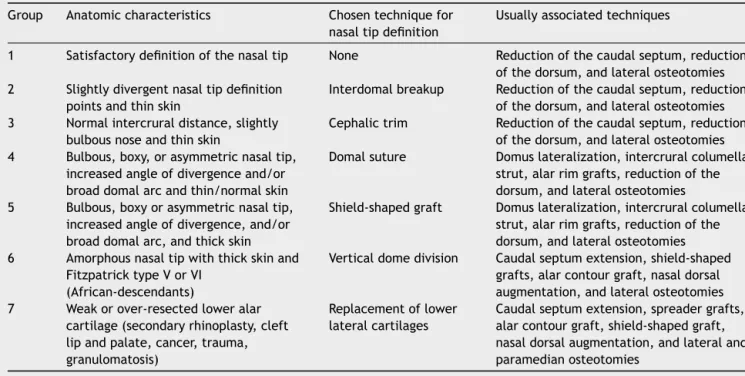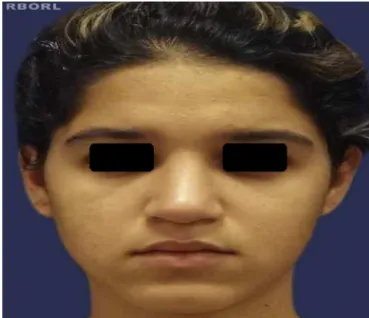Brazilian
Journal
of
OTORHINOLARYNGOLOGY
www.bjorl.org
ORIGINAL
ARTICLE
Gradual
approach
to
refinement
of
the
nasal
tip:
surgical
results
夽
Thiago
Bittencourt
Ottoni
de
Carvalho
∗,
Emerson
Thomazi,
Rafael
Panizza
Leutz,
Rafael
P.S.F.
Souza,
Fernando
Drimel
Molina,
Vânia
Belintani
Piatto,
José
Victor
Maniglia
DepartamentodeOtorrinolaringologiaeCirurgiadeCabec¸aePescoc¸odoHospitaldeBasedeSãoJosédoRioPreto-Faculdade deMedicinadeSãoJosédoRioPreto(FAMERP),SãoJosédoRioPreto,SP,Brazil
Received23July2013;accepted12April2014 Availableonline18October2014
KEYWORDS
Rhinoplasty; Nose;
Nasalcartilages
Abstract
Introduction:Thecomplexityofthenasaltipstructuresandtheimpactofsurgicalmaneuvers makethepredictionofthefinaloutcomeverydifficult.Therefore,nosingletechniqueisenough tocorrecttheseveralanatomicalpresentations,andadequatepreoperativeplanningrepresents thebasisofrhinoplasty.
Objective: Topresentresultsofrhinoplasty,throughthegradualsurgicalapproachtonasaltip definition basedonanatomical features,andtoevaluate thedegreeofpatient satisfaction afterthesurgicalprocedure.
Methods:Longitudinalretrospectivecohortstudyofthemedicalchartsof533patientsofboth genderswhounderwentrhinoplastyfromJanuaryof2005toJanuaryof2012wasperformed. Caseswereallocatedintosevengroups:(1)nosurgeryonnasaltip;(2)interdomalbreakup; (3) cephalictrim; (4)domal suture;(5) shield-shapedgraft; (6) vertical dome division;(7) replacementoflowerlateralcartilages.
Results:Group4wasthemostprevalent.Thesatisfactionratewas96%andrevisionsurgery occurredin4%ofcases.
Conclusion: Theprotocolusedallowedtheimplementationofagradualsurgicalapproachto nasaltipdefinitionwiththenasalanatomicalcharacteristics,highrateofpatientsatisfaction withthesurgicaloutcome,andlowrateofrevision.
© 2014Associac¸ãoBrasileira de Otorrinolaringologiae CirurgiaCérvico-Facial. Publishedby ElsevierEditoraLtda.Allrightsreserved.
夽
Pleasecitethisarticleas:deCarvalhoTB,ThomaziE,LeutzRP,SouzaRP,MolinaFD,PiattoVB,etal.Gradualapproachtorefinement ofthenasaltip:surgicalresults.BrazJOtorhinolaryngol.2015;81:31---6.
∗Correspondingauthor.
E-mail:cmf.thiago@gmail.com(T.B.O.deCarvalho). http://dx.doi.org/10.1016/j.bjorl.2014.04.003
PALAVRAS-CHAVE
Rinoplastia; Nariz;
Cartilagensnasais
Abordagemgradativapararefinamentodapontanasal:resultadoscirúrgicos
Resumo
Introduc¸ão:Acomplexidadedasestruturasdapontanasaleoimpactodemanobrascirúrgicas sobreoseusuportedificultamaprevisãodaformafinaldamesma.Devidoaisso,nenhuma téc-nicaisoladaésuficienteparacorrigiradequadamenteasnumerosasapresentac¸õesanatômicas, sendooplanejamentopré-operatório,abasedarinoplastia.
Objetivos: Apresentarresultadosderinoplastias,pormeiodaabordagemcirúrgicagradativa para definic¸ão da pontanasal baseada nas características anatômicas, e avaliaro grau de satisfac¸ãodospacientesapósarealizac¸ãodoprocedimentocirúrgico.
Método: Estudoemcoortehistóricalongitudinalnoqualforamavaliadososprontuáriosde533 pacientesdeambososgênerossubmetidosàrinoplastianoperíododeJaneirode2005aJaneiro de2012.Ospacientesforamdivididosemsetegrupos:(1)Nenhumacirurgianapontanasal; (2)Divulsãointerdomal;(3)Ressecc¸ãocefálica;(4)Suturadomal;(5)Enxertoemescudo;(6) Divisãoverticaldosdomus;(7)Reconstruc¸ãodascartilagensalaresmaiores.
Resultados: Ogrupo4foiodemaiorprevalência.Ataxadesatisfac¸ãofoide96%earevisão cirúrgicaocorreuem4%doscasos.
Conclusão:Oprotocoloutilizadopermitiuaassociac¸ãodaabordagemcirúrgicagradativapara definic¸ãodapontanasalcomascaracterísticasanatômicasnasais,altataxadesatisfac¸ãocom oresultadocirúrgicoebaixataxaderevisão.
©2014Associac¸ãoBrasileira deOtorrinolaringologiaeCirurgiaCérvico-Facial.Publicadopor ElsevierEditoraLtda.Todososdireitosreservados.
Introduction
Thenasaltipisthemostchallengingpartofrhinoplasty.The complexityofitsstructures,suchasthecartilageelements arrangedinavariablefashionandpositionedagainstgravity, therelativelypoorbloodsupplyandvariableskinthickness, aswellastheimpactofsurgicalmaneuversonthesupport ofthetipmakesitdifficulttopredictitsfinalshape.1
Theevaluationofnasaltipcanbestudiesitsdefinition, projection,androtation,inadditiontoitslength.Several mathematical formulas andrules have been described, in attempts to define the ideal characteristics of the nasal tip.2,3 Moreover,thethicknessandtextureoftheskinand
subcutaneoustissueenvelopehave asignificantimpacton thedegreeofdefinitionreflectedinthenasaltip.4
The description of a systematic and planned approach toachieve morepredictable resultsin nasaltipsurgeryis recent.5Sincethen,algorithmshavebeenproposedforthe
treatmentofboxynasaltipsandtoincreasethedefinition in amorphoustips through more appropriate suture tech-niquesforeachtypeoflargeralarcartilageshape,andfor thepatientskin type,butwithlittleemphasis ontheuse of grafts,especially in patients withthick skin.6,7 Due to
this fact, another algorithm was proposed to control the projection associated with nasal tip refinement in order to improve the predictability of the nasal tip surgery by usingnon-destructiveandnon-palpabletechniques, which onlyemphasizedsuturetechniquesandsomegrafts,while failingtoaddress the simplestor the evenmore complex techniques.8
Duetothemultiplicity andcomplexity ofthenasal tip deformitiesencounteredbysurgeons,nosingletechniqueis adequate tocorrect theseveral anatomical presentations of the nasal tip. Therefore, preoperative planning is the
basisofrhinoplasty.9Thus,todate,onlyonestudydescribed
thegradualandsystematicapproachtonasaltipdefinition, basedonpreoperativeanatomicalassessmentemphasizing surgicaltechniques,fromthesimplesttothemostcomplex and,thus, the present studywasbasedonthis previously describedprotocol.10
This study aims to disclose the results of rhinoplasty, throughagradualsurgicalapproachtonasaltipdefinition based on anatomical characteristics and to evaluate the degreeof satisfactionofpatientsafterthesurgical proce-dure.
Methods
AccordingtotheRegulationsonHumanResearch,Resolution 196/96oftheMinistryofHealth,thestudywasapprovedby theResearchEthicsCommitteeoftheinstitution,protocol number241.098/2013.
Table 1 Distribution by group of the proposed surgical techniques for nasal tip definition according to the anatomical characteristics.10
Group Anatomiccharacteristics Chosentechniquefor
nasaltipdefinition
Usuallyassociatedtechniques
1 Satisfactorydefinitionofthenasaltip None Reductionofthecaudalseptum,reduction
ofthedorsum,andlateralosteotomies 2 Slightlydivergentnasaltipdefinition
pointsandthinskin
Interdomalbreakup Reductionofthecaudalseptum,reduction ofthedorsum,andlateralosteotomies 3 Normalintercruraldistance,slightly
bulbousnoseandthinskin
Cephalictrim Reductionofthecaudalseptum,reduction
ofthedorsum,andlateralosteotomies 4 Bulbous,boxy,orasymmetricnasaltip,
increasedangleofdivergenceand/or broaddomalarcandthin/normalskin
Domalsuture Domuslateralization,intercruralcolumellar
strut,alarrimgrafts,reductionofthe dorsum,andlateralosteotomies 5 Bulbous,boxyorasymmetricnasaltip,
increasedangleofdivergence,and/or broaddomalarc,andthickskin
Shield-shapedgraft Domuslateralization,intercruralcolumellar strut,alarrimgrafts,reductionofthe dorsum,andlateralosteotomies 6 Amorphousnasaltipwiththickskinand
FitzpatricktypeVorVI (African-descendants)
Verticaldomedivision Caudalseptumextension,shield-shaped grafts,alarcontourgraft,nasaldorsal augmentation,andlateralosteotomies
7 Weakorover-resectedloweralar
cartilage(secondaryrhinoplasty,cleft lipandpalate,cancer,trauma, granulomatosis)
Replacementoflower lateralcartilages
Caudalseptumextension,spreadergrafts, alarcontourgraft,shield-shapedgraft, nasaldorsalaugmentation,andlateraland paramedianosteotomies
follow-up andmissingdata inthe chart.According tothe data obtained, the patients were divided into groups as showninTable1.10
Statisticalanalysis
Theresultswerepreviouslysubmittedtodescriptive statis-ticstodeterminethenormalrange.Thetwo-tailedStudent’s
t-testwasusedfor independentsamples withnormal dis-tribution and the Mann---Whitney test for non-normally distributedsamples.Whenapplicable,thechi-squaredtest wasused for comparison between variables. The level of significancewassetat5%.
Results
Ofthetotalof533patientswhounderwentrhinoplasty,158 (30%) were males and 375 (70%) were females. The age rangefor malesat the timeofsurgery rangedfrom 12to 62 years(mean26.7±8.9 years)and for females theage rangedfrom11to66years(mean27.2±8.2years),which isanon-significantdifference(p=0.3279).
Table 2shows thenumber ofpatients ineach assigned groupandaccording togender.Group4,inrelationtothe numberof patients, showedhigher prevalence (27%), fol-lowedbygroup1(26%),group3(23.1%),group5(8%),group 2(7.3%),andgroups6and7,whichhadthesameprevalence (4.3%).Allgroupshadahigherprevalenceoffemales,which wasstatisticallysignificant(p=0.0003).Figs.1---6showthe preoperative and postoperative appearance of a patient belongingtogroup4(highestprevalence),aged17yearold, female,normal skin thickness, nasal tipangle with inter-crural divergence and increased domal arch, symmetrical nostrils, sub-rotation, and convexity of the nasal bridge.
Table2 Patientdistributionn(%)ineachgroupinrelation togender.
Groups Gender pa
Male,n(%) Female,n(%)
1(n=138) 62(11.7) 76(14.3)
0.0003
2(n=39) 11(2) 28(5.3)
3(n=123) 27(5) 96(18.1)
4(n=144) 30(5.6) 114(21.4)
5(n=43) 12(2.2) 31(5.8)
6(n=23) 7(1.3) 16(3)
7(n=23) 9(1.7) 14(2.6)
a Chi-squaredtest.
Rhinoseptoplasty was performed through marginal and intercartilaginousincisions,followedbycephalicresection of lateral branches; transdomal, interdomal and septo-columellar sutures with interposition of columellar strut; dorsumreduction;andlateralosteotomies.After12months, therewasimprovementintipdefinition.
The analysis of mean age between the genders of the patientsfromeachanalyzedgroupallowedforidentification ofapproximatelysimilarmeanvaluesrevealingnostatistical difference(Table3).
Figure1 Preoperativefrontalpicture.
Figure2 Preoperativeprofilepicture.
Table3 Distribution,inmeanvalues±standarddeviation, oftheagerangeineachgroupanalyzedinrelationtogender.
Groups Gender p
Male Female
1 26.1±9.2 27.3±10.5 0.7223a
2 25.8±10.1 26.0±7.4 0.6397a
3 26.8±7.7 26.4±7.2 0.8140a
4 26.9±8.1 27.7±8.2 0.6106a
5 28.2±12.3 27.9±5.8 0.9426b
6 26.6±5.1 29.6±7.9 0.3606b
7 28.7±10.1 25.2±8.6 0.7289a
aMann---Whitneytest. b UnpairedStudent’st-test.
Figure3 Preoperativenasalbasepicture.
Figure4 Postoperativefrontalpicture.
group2(95%).Group4hadthelowestrateofsatisfaction (94%;Table4).
Discussion
The nasaltipcan beassessedbyitsdefinition, projection (distance from tip of nose tothe most posterior point of thenaso-facialjunction),androtation(cephalic orcaudal movementofthenasaltipinrelationtotheheadplane).2,3
To achieve abetter definitionof the nasaltip,every sur-geonshouldworkwiththeconceptsofconservationofthe skeleton, cartilage repositioning, and highly precise sur-gical technique. Due to anatomical variations, especially in themajor alar cartilagesandthe envelopeof skin and subcutaneoustissue,aprotocolwascreateddescribing sev-eraltechniquesfornasaltipdefinition.10 Withasystematic
Table4 Distributionofpatientsaccordingtogender,ineachgroup,inrelationtothesatisfactionwiththesurgicalprocedure outcome.
Groups Patientssatisfiedaftersurgery Patientsunsatisfiedaftersurgery Satisfactionrate,n(%)
Male,n(%) Female,n(%) Male,n(%) Female,n(%)
1(n=138) 60(43) 73(53) 2(2) 3(2) 133(96) 2(n=39) 11(28) 26(67) 0(0) 2(5) 37(95) 3(n=123) 27(22) 92(75) 0(0) 4(3) 119(97) 4(n=144) 28(19) 108(75) 2(1) 6(5) 136(94) 5(n=43) 12(28) 30(70) 0(0) 1(2) 42(98) 6(n=23) 7(30) 16(70) 0(0) 0(0) 23(100)
7(n=23) 9(39) 13(56) 0(0) 1(5) 22(96)
Total(n=533) 154(29) 358(67) 4(1) 17(3) 512(96)
Figure5 Postoperativeprofilepicture.
Figure6 Postoperativenasalbasepicture.
satisfactorypostoperativeresults,thusmakingrhinoplasty lessintimidating,despiteitsreputationasoneofthemost challengingproceduresinfacialplasticsurgery.3,5,9
Thus,thepresentstudyusedaprotocolpublishedinthe literature,10forthegradualapproachtonasaltipdefinition,
basedonanatomicalfeatures,whichallow thesurgeonto correctsimpler deformitiesin thin-skinnedpatients,using conservativetechniques,reservingthemorecomplex tech-niquesforlargertipdeformitiesinpatientswiththickskin. Of thepatients in the study (533), therewasa higher prevalence of females (70%), which was similar to that described in the literature (67.8%), although it analyzed a larger sample (641 patients).10 When patients were
distributedinthesevenstudygroups,therewasa predomi-nanceoffemalesinallgroups.Thereferencestudy10showed
nogenderdistributiondatabetweenthegroupsfor compar-isonwiththepresentstudy.
Regardingthe numberofpatients in eachgroup, there wasadifferenceinprevalencewhencomparedtothe base-linestudy,10 probablyduetodifferentregionalandethnic
characteristics between both locations where the studies wereperformed.Inthepresentstudyandinthereference study,10Group4showedalargernumberofpatients.
Whentherateofpatientsatisfactionwasassessedin rela-tiontosurgicaloutcomeineachprotocolgroup,differences were observed in prevalence between this study and the reference.10 Thesedifferences maybedue, asmentioned
above,toregionalandethniccharacteristics.
Despitethedifficultiesinherenttosurgicalproceduresin groups5, 6,and7, thepresent study found ahigherrate of satisfactionin them, when comparedto thereference study.10
In spite of differences in the sample and the physical characteristicsofpatients,theassessmentofoverall satis-factionrate ofthis study (96%)wassimilartothat ofthe referencestudy(95.6%).10However,therateofrevisionof
the present study was lower (4%) than that of the refer-encestudy (5.6%),10 although both areconsideredlow for
rhinoplasty.
Therefore,in general,the rates ofpatient satisfaction andrevisionobtainedinthepresentstudywereconsidered adequatefornasaltipdefinition,accordingtotheapproach protocolused.10 This gradualapproach canbe considered
maneuversshouldbeselectedtocorrectotherdeformities, progressingfromsimple repairstothecomplex,based on theanatomicaldiagnosis.
Conclusions
Theprotocolallowedtheuseofaprogressivestep-by-step surgicalapproachfornasaltipdefinitiondependingonthe anatomicalnasal characteristics, produced a high rate of satisfactionwiththe surgical outcome, and alow rate of revision.
Conflicts
of
interest
Theauthorsdeclarenoconflictsofinterest.
References
1.FriedmanO,AkcamT,CookT.Reconstructiverhinoplasty:the 3-dimensionalnasaltip.ArchFacialPlastSurg.2006;8:195---201.
2.PowellN,HumphreysB.Proportionsoftheaestheticface.New York:Thieme-Stratton;1984.
3.ByrdHS,HobarPC.Rhinoplasty:apracticalguideforsurgical planning.PlastReconstrSurg.1993;91:642---54.
4.WhitakerEG,JohnsonCMJr.Skinandsubcutaneoustissuein rhinoplasty.AestheticPlastSurg.2002;26Suppl.1:S19. 5.TardyME.Rhinoplasty:theartand thescience.Philadelphia:
WBSaunders;1997.
6.RohrichRJ,AdamsWPJr.Theboxynasaltip:classificationand managementbasedonalarcartilagesuturingtechniques.Plast ReconstrSurg.2001;107:1849---63.
7.Gruber RP,Friedman GD. Suture algorithm for the broad or bulbousnasaltip.PlastReconstrSurg.2002;110:1752---64. 8.GhavamiA,JanisJE,AcikelC,RohrichRJ.Tipshapingin
pri-maryrhinoplasty:analgorithmicapproach.PlastReconstrSurg. 2008;122:1229---41.
9.LopezMA,MichaelsonPG,WestineJG.Asystematicapproach for preoperative rhinoplasty planning. Am J Otolaryngol. 2008;29:265---9.


